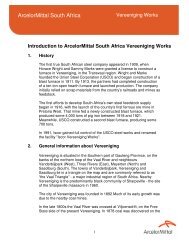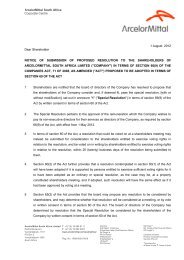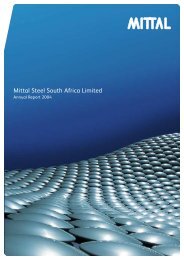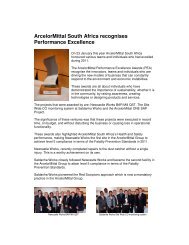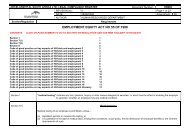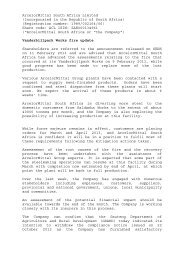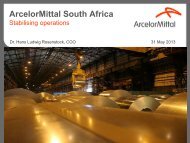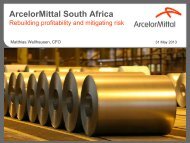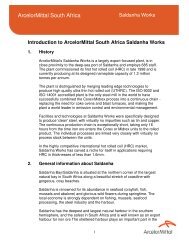Introduction to ArcelorMittal South Africa Vanderbijlpark Works
Introduction to ArcelorMittal South Africa Vanderbijlpark Works
Introduction to ArcelorMittal South Africa Vanderbijlpark Works
You also want an ePaper? Increase the reach of your titles
YUMPU automatically turns print PDFs into web optimized ePapers that Google loves.
<strong>ArcelorMittal</strong> <strong>South</strong> <strong>Africa</strong><br />
<strong>Vanderbijlpark</strong> <strong>Works</strong><br />
<strong>Introduction</strong> <strong>to</strong> <strong>ArcelorMittal</strong> <strong>South</strong> <strong>Africa</strong> <strong>Vanderbijlpark</strong> <strong>Works</strong><br />
1. His<strong>to</strong>ry<br />
<strong>ArcelorMittal</strong> <strong>Vanderbijlpark</strong> <strong>Works</strong> is one of the world’s largest inland<br />
steelworks. The increasing demand for steel during the late 1930’s and<br />
the early years of the Second World War as well as the limited opportunity<br />
<strong>to</strong> expand the Iscor Pre<strong>to</strong>ria <strong>Works</strong>, promoted the then state corporation <strong>to</strong><br />
look for a suitable site for a second steelworks.<br />
Four main fac<strong>to</strong>rs influenced the decision <strong>to</strong> establish the new <strong>Works</strong> on<br />
the banks of the Vaal River – ample space, the availability of sufficient<br />
water and electricity supplies as well as its proximity <strong>to</strong> the thendeveloping<br />
heavy industrial area in and around Vereeniging. Iscor<br />
acquired a site of 97 square kilometres (9 700 ha) for the erection of its<br />
second steelworks some 70 kilometres south of Johannesburg.<br />
By 1943, a plate mill was commissioned which produced heavy plate for<br />
ship repairs and the manufacture of armoured cars for <strong>South</strong> <strong>Africa</strong>’s war<br />
effort.<br />
The years 1947 <strong>to</strong> 1952 saw <strong>Vanderbijlpark</strong> Steel developing in<strong>to</strong> a fullyfledged<br />
integrated steelworks processing iron ore and other raw materials<br />
from mines throughout <strong>South</strong>ern <strong>Africa</strong> in<strong>to</strong> hot-rolled, cold-rolled,<br />
galvanised and tinned sheets and coils <strong>to</strong> meet <strong>South</strong> <strong>Africa</strong>’s high<br />
demand for quality flat steel products. During these years, the <strong>Works</strong><br />
production capacity was 360 000 <strong>to</strong>ns of finished products per annum.<br />
The second extension phase was from 1964 <strong>to</strong> 1968 when large<br />
extensions were added; older plants modernised <strong>to</strong> supply higher quality<br />
and value-added products such as electrolytic tinplate for the canning and<br />
beverage industries.<br />
The period 1973 <strong>to</strong> 1977 was the largest expansion period for the <strong>Works</strong>.<br />
Iron making facilities were extended and the steel making processes<br />
modernised by the commissioning of basic oxygen furnaces and electric<br />
arc furnaces. A colour coating line was established at the <strong>South</strong> <strong>Works</strong><br />
and a whole new works – the North <strong>Works</strong> – was established <strong>to</strong><br />
manufacture wide hot-rolled, cold-rolled and galvanised products.<br />
1
<strong>ArcelorMittal</strong> <strong>South</strong> <strong>Africa</strong><br />
<strong>Vanderbijlpark</strong> <strong>Works</strong><br />
2. Processes<br />
2.1 Brief description of processes<br />
Iron Making<br />
The Iron Making Department consists of a raw material handling area,<br />
sinter plant and two blast furnaces. Raw materials such as iron ore, sinter<br />
coke and dolomite are charged in<strong>to</strong> the blast furnaces where it is<br />
converted <strong>to</strong> liquid iron.<br />
<strong>Vanderbijlpark</strong> <strong>Works</strong> has two blast furnaces in operation with a combined<br />
capacity of 240 000 <strong>to</strong>nnes <strong>to</strong>nes of liquid iron monthly.<br />
Direct Reduction<br />
The Direct Reduction Plant is coal based and has six rotary kilns currently<br />
capable of producing 900 000t of direct reduction iron, or DRI. The main<br />
consumer of this product is the Electric Arc Furnaces.<br />
Coke Making<br />
The Coke Making Department produces coke from the carbonization of<br />
high grade coking coal. The coke is a raw material for use at the Blast<br />
Furnaces. The Coke Making Department consists of 6 coke batteries and<br />
there are a <strong>to</strong>tal of 334 ovens in the 6 batteries. The plant has the capacity<br />
<strong>to</strong> produce 1.4m <strong>to</strong>ns of Coke per annum. The gas generated form the<br />
carbonization of coal is used in internal heating processes at<br />
<strong>Vanderbijlpark</strong> - mainly at the Hot Strip Mill and the Plate mill. Commercial<br />
grade coke can also be produced when there is spare capacity available.<br />
3
<strong>ArcelorMittal</strong> <strong>South</strong> <strong>Africa</strong><br />
<strong>Vanderbijlpark</strong> <strong>Works</strong><br />
Steel Making<br />
The Steel Making department consist of an Oxygen Steel Making route, a<br />
Direct Reduction Unit and an Electric Steel Making route.<br />
The premier steel making facility at <strong>Vanderbijlpark</strong> <strong>Works</strong> is the Oxygen<br />
Steel Making facility which consists of three 170 t basic oxygen furnaces<br />
(or BOF’s), two ladle furnaces and a Ruhrsthal Heraeus or RH degasser in<br />
line with two twin strand slab casters.<br />
The plant has a capacity of approximately 3 million <strong>to</strong>ns liquid steel and<br />
produces various grades for Au<strong>to</strong>motive, Plate, Tin as well as Draw and<br />
Wall Ironing or DWI, applications.<br />
The Electric Steel Making route consists of three 155t eccentric bot<strong>to</strong>m<br />
tapping Electric Arc Furnaces, two Ladle Furnaces, a Vacuum Arc<br />
Degasser (VAD) and twin strand slab caster. Current capacity of the plant<br />
is around 1.3 million <strong>to</strong>ns liquid steel and produces mainly Plate Mill, Pipe<br />
and Galvanised applications.<br />
Rolling<br />
Slabs are hot rolled in<strong>to</strong> heavy plate in the plate mill, or in<strong>to</strong> coils in the hot<br />
strip mill. The coils are either sold as hot rolled strip or processed further<br />
in<strong>to</strong> cold rolled and coated products, such as hot dip galvanised, electrogalvanised<br />
and pre-painted sheet, and tinplate.<br />
Hot Strip Mill<br />
Hot rolled coils ranging between 1.5mm <strong>to</strong> 23mm in thickness and widths<br />
of 750 <strong>to</strong> 1850mm through four furnaces, a 2-stand roughing mill, a 7-<br />
stand finishing mill and three coilers.<br />
Slabs are reheated <strong>to</strong> approximately 1250 ˚C depending on product,<br />
reduced in the roughing mill from 240mm <strong>to</strong> the required transfer bar<br />
thickness of between 30 and 42mm. The transfer bar is then processed<br />
through the finishing stands and coiled.<br />
4
<strong>ArcelorMittal</strong> <strong>South</strong> <strong>Africa</strong><br />
<strong>Vanderbijlpark</strong> <strong>Works</strong><br />
Plate Mill Route<br />
Slabs are reheated in the plate mill furnaces and rolled in<strong>to</strong> plates ranging<br />
between 5mm <strong>to</strong> 100mm in thickness and widths of up <strong>to</strong> 3500mm in<br />
different lengths. The plates cool down on the cooling beds before it goes<br />
through the different cutting units. Special grade plates get treated at the<br />
Plate Treatment Plant <strong>to</strong> achieve improved steel properties and wear<br />
resistance.<br />
Cold Rolling<br />
Hot rolled strip from the Hot Strip Mill is received at Continuous Pickling<br />
lines where scale is removed using Hydrochloric Acid. Coils are then sold<br />
in the pickled and oiled condition or sent for further processing at the 5-<br />
Stand Tandem Cold Mill. The material can then be processed further via<br />
two routes. The first route is through Batch Annealing, Temper Mill and<br />
Electro-galvanising Line where electro-galvanised material is produced for<br />
the au<strong>to</strong>motive industry.<br />
The second route is through the Continuous Annealing Line and a Hot Dip<br />
Galvanising Line where galvanised material is produced for dispatch or<br />
further processing at the Paint Line.<br />
Tinning Line<br />
Cold rolled coil is firstly annealed and then tempered <strong>to</strong> get the desired<br />
surface and metallurgical properties for the tinning process where the<br />
base metal is electrolytic alloy coated with tin for the food and beverage<br />
industries.<br />
Galvanising Line<br />
Cold rolled coil is heated in a reducing furnace and then coated with<br />
molten zinc using a hot dip process. The thickness of the coating is<br />
determined by air force applied on the strip. It can also be tempered and<br />
further processed through the Colour Line.<br />
5
<strong>ArcelorMittal</strong> <strong>South</strong> <strong>Africa</strong><br />
<strong>Vanderbijlpark</strong> <strong>Works</strong><br />
Colour Coating Line<br />
Galvanised coils are painted different colours for different end uses such<br />
as the appliance and construction industries.<br />
Process Flow Chart<br />
6
<strong>ArcelorMittal</strong> <strong>South</strong> <strong>Africa</strong><br />
<strong>Vanderbijlpark</strong> <strong>Works</strong><br />
General information about <strong>Vanderbijlpark</strong><br />
<strong>Vanderbijlpark</strong> is an industrial city next <strong>to</strong> the Vaal River. The <strong>to</strong>wns of<br />
<strong>Vanderbijlpark</strong>, Vereeniging and Sasolburg lie in a triangle on the map and are<br />
commonly referred <strong>to</strong> as “the Vaal Triangle” - a major industrial region of <strong>South</strong><br />
<strong>Africa</strong>. <strong>Vanderbijlpark</strong> is located in the district municipality of Sedibeng (which<br />
incorporates the local municipalities of Emfuleni, Midvaal and Lesedi). Since<br />
1999, <strong>Vanderbijlpark</strong> has been part of the Emfuleni Local Municipality, along with<br />
Vereeniging and Three Rivers. The black <strong>to</strong>wnships Boipa<strong>to</strong>ng, Bophelong,<br />
Sebokeng and Sharpeville are close <strong>to</strong> the city.<br />
<strong>Vanderbijlpark</strong>'s 500 000 trees shade streets named after scientists, engineers,<br />
composers, poets, writers and medical practitioners. They house one of the most<br />
cosmopolitan communities in the country.<br />
<strong>Vanderbijlpark</strong> started when Dr HJ van der Bijl, a brilliant young scientist working<br />
in the United States at the time, was called back <strong>to</strong> <strong>South</strong> <strong>Africa</strong> in 1920 by the<br />
then Prime Minister Jan Smuts <strong>to</strong> advise the government on planning <strong>South</strong><br />
<strong>Africa</strong>'s industrial development. Van der Bijl oversaw the Iron and Steel<br />
Corporation's first plant at Pre<strong>to</strong>ria, but with the increased demand after World<br />
War II, 100 km² was bought <strong>to</strong> build a large steel works and model <strong>to</strong>wn. The<br />
steel works began operating in 1947 and the <strong>to</strong>wn was proclaimed in 1949. The<br />
<strong>to</strong>wn attained municipal status in 1952.<br />
7




